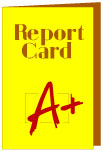
The March 5-8 visit from the Southern Association of Colleges and Schools reaffirmation committee is complete, and our campus can breathe a sigh of relief. Palo Alto received a highly positive report, with only 20 recommendations out of 362 categories.
SACS Reaffirmation Committee Chair, Dr. David Goetsch of Fort Walton Beach, Fla., likened the small number of findings to receiving
Recommendations are those areas that must be fixed in order for an institution to remain accredited. The Self-Study, which is required by SACS of all colleges in the region, rolled into action during the Fall of 1999 to prepare for the SACS visit. Two years of work by many Palo Alto faculty, staff and students paid off with the Reaffirmation Committee’s statement of their findings.
"We thought we had 46 criteria that were not in compliance," said Dr. Dorothy Haecker, professor of Philosophy and director of the Self-Study. "The SACS reaffirmation committee found us to only have 31 [including suggestions]."
There were 11 suggestions made to the campus, which would improve the campus, but are not mandatory. The 20 recommendations must be completed, or in the midst of being completed, when the Palo Alto team writes its response to the Reaffirmation Committee’s findings.
"Each one of the 20 recommendations is a win," Haecker said. "They give the college an opportunity to improve, and that is better for everyone involved."
One such win for the campus is the fact that the advising program is being reworked. There are plans to create a process that is smoother for students to find a career and transfer to other schools.
The recommendations that the SACS report cited include Palo Alto employing a certain ratio of adjunct faculty to full-time. It is required that colleges have a faculty that consists of 65 to 80 percent full-time personnel. This is to ensure that students always have a full-time faculty member they can go to in their discipline.
Also, Palo Alto is becoming more involved in intramural sports as a result of the Self-Study, not just the SACS’ recommendation. Palo Alto has a full-time director, who is organizing the intramural and extramural activities.
Now that the Self-Study process is complete, Haecker said the rest is easy."Up until now, we had 400 items we were focusing on," Haecker said. "It’s come down to the final 20 to address and correct. What remains is so easy by comparison and really fun; it’ll be what makes all the difference."
According to Haecker, the most time-consuming and grueling part of the report was collecting and documenting sources and exhibits that back up the findings the Self-Study report and putting them into a library. The SACS visiting team looked at the Self-Study report and confirmed or disagreed with the findings.
The ‘library’ is an extensive collection of documents—10,000 pages to support the 400-page report. The library was housed in 14 crates of hanging folders plus a bookcase of notebooks.
"It was a little bit of overkill, but it was better to have too much information to backup our findings rather than too little," said Diane Beechinor, assistant professor of Biology and Self-Study library coordinator.
An editing committee was just one of the many committees assigned to ensure the Self-Study’s success . This committee was headed by Ellen Shull, English professor, and Dr. Mary-Ellen Jacobs, chair of the English department.
"The most difficult part of writing the report was creating a unified voice," Jacobs said. "There were multiple authors for each section, and we had to thread each section together. We had to create enough context in each section about Palo Alto and who we are so that the section could be read completely independent," Jacobs said. Creating unity in the document bred a feeling of unity on campus.
"We developed unification among ourselves," Jacobs said. "It became very apparent that this was an institution-wide effort."
By August 1, Palo Alto has to write a response to the Reaffirmation Committee’s report, and explain how each recommendation has been fixed or is going to be fixed. Based on this report, SACS will determine if Palo Alto qualifies for reaccreditation. A decision will be reached in December with the conditions of our reaccreditation. Until then, Palo Alto can bask in its A+.